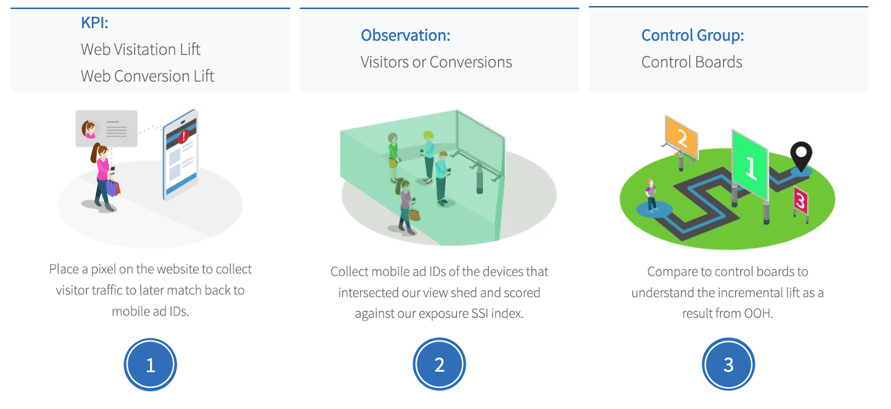Traditionally, Out-of-Home (OOH) has been considered a more difficult-to-measure channel compared to its digital counterparts. Connecting how OOH affects a brand’s online presence can seem challenging. But the world, our interactions, and how we transact are all now digitized. The same is true for OOH and its growing capabilities for measurable results. Using OOH technology advertisers can connect their OOH advertisements to a lift in website traffic, page views, and even online sales. Billups Web Impact Studies are designed to help advertisers measure OOH's impact on online web metrics.
In this article, you’ll learn how we conduct our Web Impact Studies and how we collect data from outdoor ads and web traffic to provide you with insights.
What is a Web Impact Study and How Does it Work?
Our Web Impact studies track KPIs related to web activity. Measurable KPIs include visitation lift, page views, or online sales on a brand website.
Here are the steps we take to conduct the study:
- Track exposures via view shed technology that determines which devices were exposed to an OOH unit.
- Collect web data related to tracked KPI. Web data could be collected from first-party data, Google Analytics, or pixel solutions.
- We resolve cookies and IP addresses from web activity and match them to mobile ad IDs from exposures. For Google Analytics results, we select control markets for modeling predictive results.
- Control groups are utilized via exposure data to determine what lift had occurred due to an OOH exposure.

The above graphic depicts how our process works. We implement control boards for our OOH attribution studies to further validate that the lift in web visitation was indeed attributable to OOH advertising. To find out whether a Web Impact Study is feasible for your brand, it's important to understand the requirements Billups has for its studies.
Requirements for Web Impact Studies
We want to ensure that we provide value to our clients with our studies. We always run feasibility checks beforehand to determine whether the study fits well. For Web Impact Studies, we recommend the following:
- Market Reach: Like our other studies, we adhere to market reach standards for statistical significance within each market. Our threshold is 20% of the market population or 500,000.
- Campaign Duration: The campaign needs to be at least four weeks long.
- Unit Count: There needs to be a sufficient number of units in the campaign to be tracked.
- Timing: Unlike our Location Visitation Studies, we cannot conduct Web Impact Studies retrospectively. The pixel needs to be on the website two weeks pre-campaign through two weeks post-campaign to track visits that could be attributed to the OOH.
- Pre-Planning and Production: We recommend planning for a Web Impact Study at least six weeks before the campaign begins. These studies take quite a bit of time to set up and deploy. Planning before the campaign starts ensures the time necessary to check feasibility, place pixels if needed, and allows for sufficient production time.
- Conversion Rates: We recommend that companies already have a daily baseline of conversions of 300 to 500. This is because if you have a low conversion rate, you may see a high lift in terms of percentage, but it will still be a meager number. For example, if you have ten daily conversions on your website and through OOH, it’s increased to 15, you have increased your conversion rate by 33%, but it is still only five additional conversions.
Drive Traffic to Your Website with Billups
How can you track your online performance through an offline channel? Billups' patented technology allows us to conduct Website Impact Studies that can tell you down to the unit what is driving performance to your site. Contact us to conduct a Web Impact Study or learn more!

